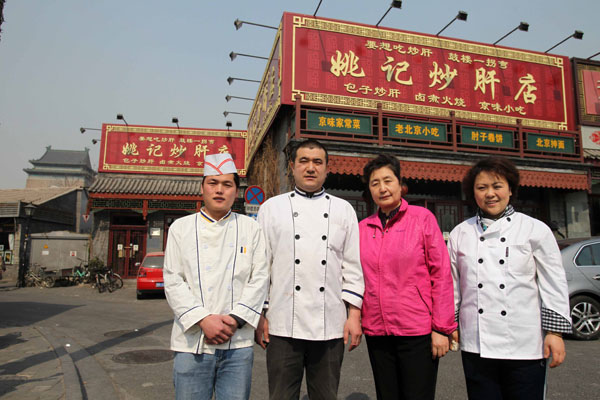
From left to right are Yao's Chaogan chef Zhao Huawen, third-generation owner Yao Long, second-generation owner Yao Yan, and Yao Long's wife Jin Qinshu, in front of their now famous restaurant. Photos by Wang Jing / China Daily
Every hour is peak hour at Yao's Chaogan restaurant. The line streams outside the building as the clock strikes 11 am.
The eatery next to the southeast corner of Beijing's Drum Tower offers Beijing fare, including the No 1 seller, chaogan - pork liver, lungs and intestines served in a thick broth with minced garlic - from which the restaurant takes its namesake dish.
The 300-square-meter restaurant became world-famous overnight when US Vice-President Joe Biden made a lunchtime stop there in August 2011.
It has received fresh waves of visitors since an Internet rumor spread that it will be torn down in the renovation of the area surrounding the drum and bell towers.
The first phase won't touch the establishment, 58-year-old second-generation owner Yao Yan says. "But I can't say the same for Phase 2."
Yao recalls growing up in the area, which was chockablock with toy stores and snack shops. The sounds of bargaining in Beijing dialect dominated what was then one of the city's six busiest areas.
Her father, Yao Moxian, started the business when he saw the long lines in front of temporary breakfast stalls. So he decided to jump into the business in 1989, at age 76.
It sold chaogan and stuffed steamed buns in a 20-sq-m private house with just four tables. But it quickly became too popular.
"Customers ate outside with umbrellas on rainy days," Yao Yan recalls. "Even in winter, they stood outside and used bicycle seats as dining tables."
In 2000 the Yao family rented the neighbor's 100-square-meter house for the restaurant and tripled the size in a 2008 expansion.
Yao Yan says the restaurant has become part of residents' collective memories.
Houses in the south Drum Tower area across the street were demolished a few years ago for subway construction. But relocated residents often return to the restaurant to recall the good old days, Yao says.
Ma Shuqin rides her bike for an hour to the eatery on weekends from her home outside the Fourth Ring Road.
"I've been eating here since the day it opened," Ma says.
Its allure is growing among new customers, too, as more tourists visiting the two towers know its reputation, Yao says.
Zhang Chi, a 22-year-old migrant worker from Anhui province, brought his friend Xiao Hui to the restaurant for Xiao's first trip to Beijing as part of their "most original Beijing tour".
"The flavor's a bit heavy for southerners like us," Zhang says. "But it's original. It is what it is."
Another eatery that has become a fixture of the neighborhood won't survive the first relocation, its owners say.
Ren's Baodu has bleated Peking Opera from its loudspeaker since its 1986 opening.
"If I can't find another place, my only choice is to close," 59-year-old owner Ren Zhiqiang says.
If the place closes, Ren's family is out of work.
But Yao's eatery has around 30 employees. Those who aren't family members are migrant workers.
Zhu Junwei and Gu Xiaoying, a couple from Gansu province, have worked at Yao's Chaogan for more than five years.
"We count on this job," Zhu, 32, says.
"If we lose it, we also lose our free meals and housing."
Yao plans to open a new branch near Beixinqiao in Dongcheng district.
The 400-sq-m establishment is decorated in traditional style and customers can order from their seats without lining up. But quality and prices will be the same, Yao says.
Yao hopes her restaurant can reopen in the Drum Tower area after the renovation.
"The Drum and Bell towers area is to Beijing what the City God Temple to Shanghai and the Confucius Temple to Nanjing - the locus of original food culture."

Copyright ©1999-2011 Chinanews.com. All rights reserved.
Reproduction in whole or in part without permission is prohibited.